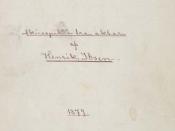Naturalism is used in "A Doll's House" by Henrik Ibsen (1879) and "Miss Julie" by August Strindberg (1888) in a satirical way to portray the female protagonists as victims of society and circumstance. The playwrights castigate society and expose its constrained views. The females have been placed in a 'gilded cage' and due to society's insidious nature; the characters are oblivious to their cages. The 'gilded cage' symbolizes the stifling of the individual and both plays lead our heroines on a quest which results in the anagnorisis of their gilded cages. The evidence of the phallocentric era is present in both plays and each playwright gives their character a way out of their cages to escape the oppression. Strindberg's view coincides with phallocracy but Ibsen's view contrasts it, they are didactic in their plays in how women can act. Both show a degree of verisimilitude in the likelihood of outcomes in their respective plays.
We are lead to believe that Nora is weak and ignorant but emerges strong and insightful, while Julia is portrayed as strong but her implied strength turns out to be her detrimental weakness. The overwhelming discovery of their comfortable but restrictive cages leads each to choose a way out.
The gilded cage metaphor applies to both female roles because each private setting is warm and comfortable shown by the heat sources on each stage: the fireplace in A Doll's House and the stove in Miss Julie. In a symbolic sense Nora's and Julie's houses captivate them, they are allowed to leave temporarily but must always return to their cage as pet birds do. Furthermore both houses are provided by males showing that they are both stifled by men, though unaware of it. In A Doll's House the metaphor "little skylark" used by Torvald in...


